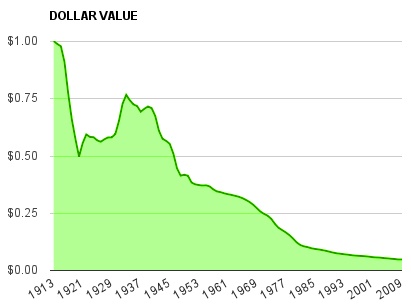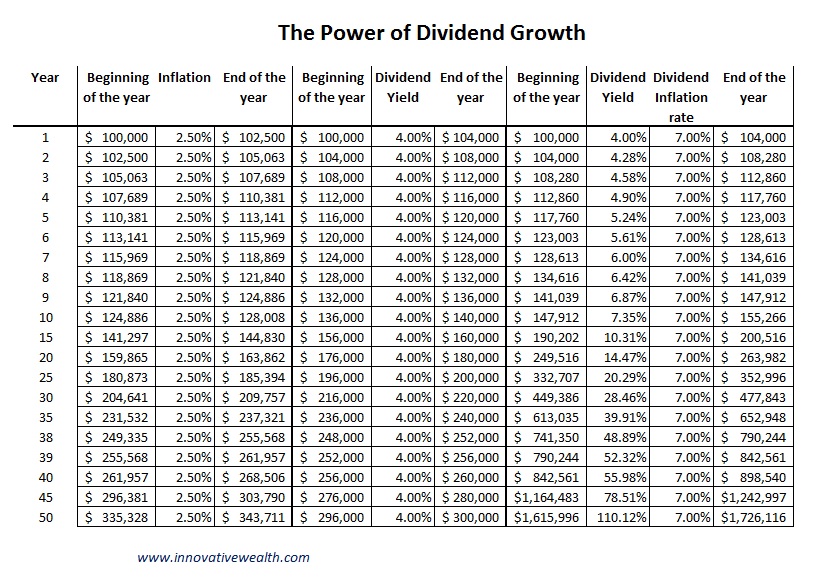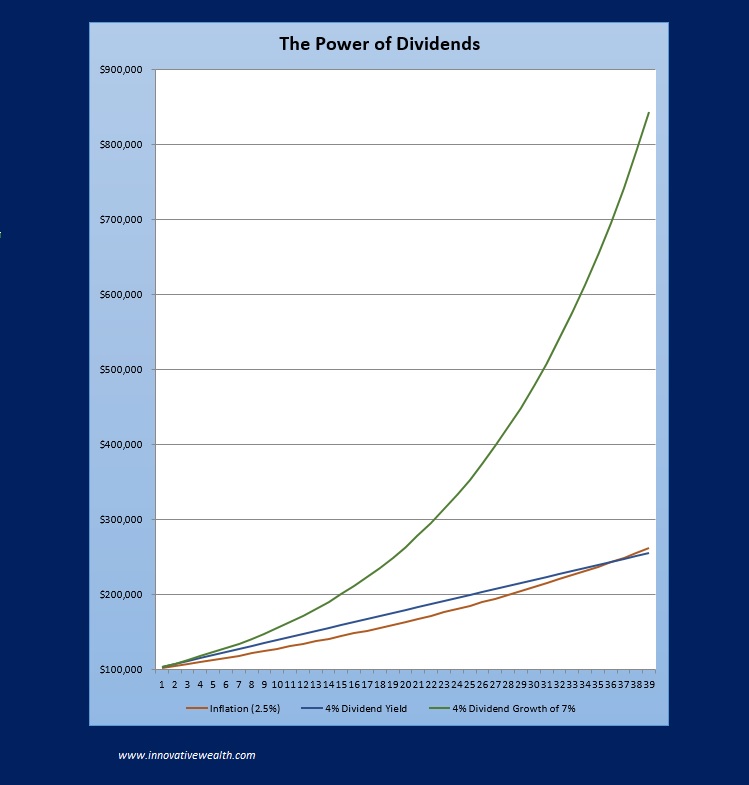Dividend Growth – Learn How This Simple Secret Can Exponentially Increase Your Returns

“Inflation is taxation without legislation” – Milton Friedman
Inflation may provide some benefit to society as a whole, but it also ravages many parts of that same society. Over time, sustained inflation will eat away the foundation of a strong economic system. The US has experienced sustained inflation for approximately the past 60 years. This is the longest sustained period of inflation in the history of the United States. While we don’t know what the future holds, other countries such as Japan may provide some hint of things to come. The Innovative Advisory Group Inflation Monitor, which we will be releasing next week, will briefly discuss Japan and what can happen after inflation subsides.
Regardless of what happens in the future with inflation in the US, it is important to consider how it will affect your investment portfolio. While I discussed how a hypothetical dividend stock could help you compound the growth of your family’s wealth in the first three parts of this series, I have not mentioned how the effects of inflation can eat away at this performance. This fourth article in the series will discuss both how inflation affects your investments, and how to use dividend stocks to beat inflation. This inflation beating secret could help you minimize the effects of inflation through another form of compounding or super-compounding.
Inflation – How it affects you and why you should be concerned
Inflation is a silent tax on a person’s wealth. It slowly erodes the purchasing power of a person’s cash. Let’s say you have $100 in cash today. It can buy $100 in chocolate at the store. If inflation is currently at 3% annually, then next year your $100 will be worth $97 in purchasing power. This means that while you still have $100, the same amount of chocolate you bought last year for $100 will be priced at $103 in the following year. The number of dollars you have has not changed, but the price of the chocolate you want to purchase with that $100 has gone up in price. Hence the value of your dollar has declined in comparison to that chocolate. Here is a chart of the effects of inflation on the US dollar in the past 100 years. This chart shows what a dollar from 1913 could buy you today.

A dollar from 1913 is now worth pennies on the dollar
The existence of persistent inflation eventually causes people’s behavior to change. A persistent slow rate of inflation eventually forces people to take risks with their wealth in order to not lose their purchasing power over time. This is why people invest in stocks, bonds, and other investments instead of keeping their wealth in cash. Conservative investors who hope to get 5% interest from a bank CD, are not taking a lot of risks, as long as the bank carries insurance for its deposits. However, that person is also most likely keeping pace with the rate of inflation, and not exceeding it. Of course, this rate usually doesn’t account for taxes, but that is the subject of another issue.
Inflation is a disincentive for cash to sit under your mattress. It forces savers to use their cash more productively. It also forces savers to take risks with their cash. This is unfortunate since it is not always optimal to invest cash into investments. Many times, such as 2000-2002 or 2008, it may be better to keep your wealth in cash. This inflationary effect almost requires that all savers become investors.
Why invest in dividends stocks if inflation will just eat away at your dividend yield?
Inflation can slowly and silently inflate away the future purchasing power of your wealth. In order to prevent that, you need to have a strategy that allows you to outpace the rate of inflation. As I have shown in the prior three articles of this series, dividend stocks are one of the more powerful ways to grow your wealth over time. In order to maximize the potential for growth, you will need to focus on three things:
- Time – The most important element in all investing.
- Dividend reinvestment – What allows you to take advantage of the principle of compound interest.
- Dividend growth – The secret of super-compounding.
Each one of these three things by itself can help you outpace inflation, but if you are able to combine all three together, your results will be astounding.
The secret of dividend growth stocks
Dividend Growth is frequently overlooked by both novice and experienced investors. Dividend growth is when a dividend stock pays a consistent dividend, and over time increases that dividend. While it is always nice to see one of your dividend stocks increase their dividend, it is more important to understand when there is a moral obligation to increase that dividend each year. This moral obligation is one of the real secrets to dividend growth and creating generational wealth.

Beating inflation via dividend growth
Let’s start by explaining the principal of dividend growth, then we can discuss one of the secrets to finding these types of stocks.
This chart (chart 1) shows the rate of inflation (2.5%) and two dividend stocks (both starting with a 4% dividend yield). Let’s continue to use chocolate to calculate inflation and as the comparison against stocks. One stock ( stock A) pays a consistent 4% dividend yield, and the other stock (stock B) starts paying 4%, but the dividend yield grows at a rate of 7% a year. You will notice a couple of interesting things from this chart.
- Inflation Rate – The rate of inflation naturally compounds since the inflation rate is compared to the prior year when reported. If you notice on chart 1, after 38 years the price of chocolate grows from $100,000 to $249,355 (yes that is a lot of chocolate), while stock A paying a 4% dividend (not reinvested) grows to only $248,000. Using these numbers, this means that if you are living off your dividends, in 38 years, you will start to lose your purchasing power of those dividends. Now you might not care since it is 38 years away, but the principal is important to remember since you are trying to outpace inflation and build generational wealth.
- Dividend growth – You will notice that the 4% dividend yield you receive from stock B increases each year by 7%. This is compound growth. This has an exponential growth effect on your income, which is generated from the stock, and your total wealth. You will notice in that same 38 years that it took inflation to catch up to stock A, the dividend yield of stock B has grown to over 12 times the original 4% to 48.89%. This is a very powerful concept. How would you like to earn 48.89% on your original invested amount each year?

How do I find dividend stocks that have growth?
There are quite a few stocks that pay dividends, so finding the ideal candidate may not be easy if you don’t know where to look. If you want to add dividend stocks to your portfolio and are looking for stocks that have similar characteristics to what I have described, you have two choices. You can either try to do the research yourself or you could use a professional who specializes in this area.
If you are looking to do it yourself, then you should consider one of the most important secrets to finding dividend stocks with these qualities which I have described. What is that one thing?
Moral Obligation
A dividend is cash paid out to a company’s shareholders. This act of paying a dividend is considered shareholder friendly. It is also received positively by the investor community as long as the company’s cash flow can support the dividend. Investors who seek out dividend stocks typically are looking for income and growth as their investment objectives. The companies which typically draw this crowd are ones which have paid out dividends for a long period of time.
As a company continues to pay out dividends over longer and longer periods of time, an expectation builds up within the investor base of the company’s shares. This expectation is that investors expect those dividends to continue each year, or even increase. This expectation of the company to pay the same or more dividends each year is called a moral obligation. There is nothing contractual that requires the company to pay out a dividend or to pay it on a consistent basis, but many of them do. A corporate bond is a contractual obligation the company makes to pay back the principal borrowed plus any agreed upon interest. A dividend does not have this type of structure.
Consistent dividend payments are important to shareholders because they increasingly rely on it as part of their investment performance. So if a company eliminates or reduces the company dividend, it can scare existing shareholders into selling their shares because they were relying on that dividend as part of their annual performance. It is also not a good sign when a company reduces the dividend due to cash flow needs.
This moral obligation to continue to pay out dividends is generally understood by the company’s management. They understand what reducing or eliminating the company dividend would do to the stock price. This gives them a strong incentive to continue to pay out dividends regardless of economic conditions. This moral obligation incentive held by the management is one of the items we look for when researching stocks for our portfolios. If your dividend stocks do not have a moral obligation to pay out their dividends, then you should consider how reliable those dividends are in your portfolio.
How can you make this work for you?
Dividend growth is an important component when choosing dividend stocks. However, it is not the only factor to consider. There are three components to maximizing the performance of your dividend stocks. I discussed this in the prior article of this series, Three Dividend Secrets that could make you a World-Class Investor. If you want to maximize your performance, you need to have all three components working for you. In the next article in the series, Supercharge your dividend stock investing, I will put them all together to illustrate how this can work for you.
This article is intended solely for informational purposes only, and in no manner intended to solicit any product or service. The opinions in this article are exclusively of the author(s) and may or ...
more


